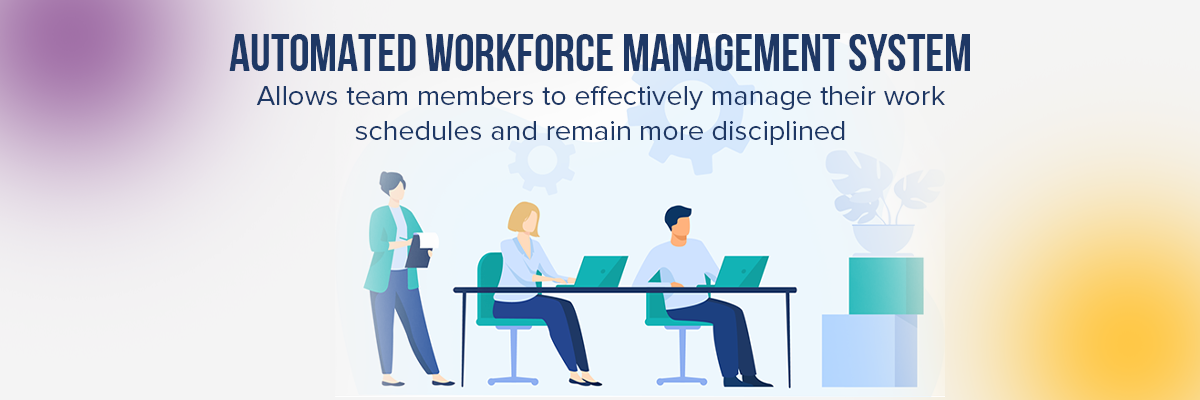Think of a startup with a small team of 50-100 people. As a team manager, you have to spend hours with employee scheduling and labor forecasting. The ultimate goal of this effort is to deploy the right person with relevant skills and expertise to deliver impeccable results.
However, this manual process of staff scheduling and team management is very time-consuming. Doing these repetitive tasks with traditional pen-and-paper methods becomes tedious quickly and declines your overall productivity. So, how to optimize staff performances and make teams more productive in shift-based work environments?
The answer is shift management automation, which streamlines the employee scheduling process and helps managers create shifts in minutes. Let’s explore some of the key benefits of using automated shift management software for small businesses.
What is Automated Shift Management?
Automated shift management is a tech-based approach to streamline the employee scheduling process. It is a digital way of team management that combines artificial intelligence with a company’s predefined parameters to automate the shift management process.
Cloud shift management tools replace manual scheduling with fully automated solutions. Besides, they give managers real-time visibility into employees’ schedules and eliminate monotony at higher levels. Eventually, automation speeds up the decision-making process which ultimately improves workplace efficiency and results in higher team productivity.
The Need for Automated Shift Management
In today’s fast-paced business environment, staff managers have to make quick decisions based on real-time insights to stay ahead of their competitors. Automated shift management enables supervisors to schedule employee shifts and manage teams with automation. The technology eliminates the need for manual shift management which is time-consuming and prone to errors.
Moreover, employers can use automated shift management software to create weekly or monthly schedules in advance. They can build the staff rota based on employee availability, skills, and preferences. Similarly, the software makes the process smoother by handling shift swaps and employee requests for time off.
Particularly, small businesses can use these cloud-based solutions to run their operations run smoothly, minimize labor costs, and increase employee satisfaction.
Benefits of Automated Shift Management for Small Businesses
Given below are some of the key benefits of automated shift management for small businesses:
1. Efficient Use of Time and Resources
Ask any employer about the value of time. Over 9 out of 10 times, you will get the same answer that time is the most valuable asset for any organization. Better time management leads to higher productivity and ultimately translates to long-term financial benefits.
The biggest benefit of automated shift management is that it enables managers to save their precious time and focus on the most critical tasks. By eliminating the need for manual scheduling and checking the availability of employees one by one, you can build advanced employee schedules with just a few clicks.
Automated software keeps you updated on available staff, shift requirements, and shifts closed or in progress. This helps you effectively utilize your resources and deploy qualified professionals for better results.
2. Significant Cost Reduction
Have you ever calculated the approximate cost of overtime at your organization? According to the Bureau of Labor Statistics (BLS), more than 55% of companies are paying overtime to their staff in the US. Besides, the estimated cost of overtime increased by 8.7% from 2020 reaching an all-time high of $924 million in 2021.
Automated scheduling is the best solution to control overtime costs and significantly reduce overall expenses related to team management. Cloud-based shift management software allows managers to share the shift details with their team members and track the time once the shift has started. The system automatically calculates the time spent by each employee on different shifts.
At the end of the week or the month, managers can download detailed reports about workable hours, employee wages, and profits. This way, accuracy in time tracking and cost estimation leads to financial benefits and ensures transparency.
3. Strategic Planning
Strategic planning based on data-driven decisions results in long-term sustainability and business growth. Employers need real-time information to make strategic plans about their teams and better utilize the available resources.
For this purpose, automated shift management tools can be used to get accurate and real-time data on employee availability, schedules, and attendance. Managers and team leads can use this data to estimate their staffing needs or forecast future scheduling requirements. Similarly, strategic planners can use this data to make data-driven decisions about staffing levels and resource allocation.
4. High ROI and Profits
Optimizing staffing levels and minimizing overtime not only reduces labor costs but also results in high ROI. With the right automated shift management tools in place, businesses don’t need to allocate multiple resources to do the assigned tasks. Instead, automation frees up time for managers to focus on strategic planning and decision-making and focus on business development for increased profitability.
Similarly, when employees are scheduled for the right shifts and tasks, businesses can achieve higher productivity levels. Besides, they can make sure that their staff has the right skills and experience leading to improved efficiency.
By accurately forecasting scheduling needs and making sure that the right employees are scheduled for peak times, businesses can also improve customer satisfaction and loyalty.
5. Happier Workforce
One of the best ways to keep the modern workforce happy and satisfied is by offering flexible scheduling options. This becomes possible with automated scheduling tools that empower staff to manage their own schedules and maintain a healthy work-life balance.
Automated systems allow employees to easily swap shifts or request time off. By giving employees more control over their work schedules, businesses can improve employee satisfaction and reduce turnover. Likewise, leveraging automated shift management solutions also enables businesses to improve employee retention and reduce turnover.
Finally, companies can improve communication between managers and employees by automating their shift management process. This ensures that everyone is on the same page and enables managers to quickly respond to changes in scheduling needs or business requirements.
6. Enhanced Compliance and Transparency
Automated shift management serves as a comprehensive solution that extends beyond mere scheduling efficiency to guarantee strict adherence to labor laws and internal company policies. By incorporating compliance parameters directly into the system, such as regulations governing maximum working hours and mandatory break periods, automated shift management becomes a vigilant guardian against unintentional policy violations.
Furthermore, the software generates detailed and easily accessible reports, offering a profound level of transparency into various aspects of employee work hours, breaks, and overtime. These reports provide a granular overview of workforce activities, empowering managers and stakeholders with insights that go beyond scheduling logistics. This transparency not only facilitates internal decision-making processes but also plays a pivotal role during compliance audits.
7. Improved Employee Engagement

The implementation of automated systems empowers employees with unprecedented control over their work schedules. Through intuitive interfaces, staff members can effortlessly access their schedules, initiate requests for time off, and seamlessly execute shift swaps, all within the automated framework. This level of self-determination not only streamlines administrative processes but also instills a profound sense of control and autonomy among employees.
Additionally, the introduction of such self-service functionalities aligns with the contemporary workforce’s desire for flexibility and work-life balance. By entrusting individuals with the ability to manage their schedules, automated shift management contributes to a workplace culture that values the unique needs and preferences of each team member. This sense of empowerment becomes a cornerstone for fostering a positive and satisfying work environment.
8. Integration with Payroll
Beyond its evident advantages in scheduling efficiency, one of the less highlighted benefits of automated shift management is its integration with payroll systems. This integration represents a pivotal bridge between workforce operations and financial processes, streamlining the entire compensation workflow.
By automating the transfer of relevant data, this integration not only saves considerable time for the payroll department but also ensures that employees receive precise and timely compensation for their efforts. The accuracy achieved through automated integration contributes to a more transparent and trustworthy payroll process. Employees can have confidence that their financial transactions align meticulously with the actual hours worked, fostering a sense of trust and reliability in the organization’s payroll procedures.
Final Words
Small businesses with limited resources and budgets often face one challenge: How to optimize their resource utilization to achieve their desired goals. Besides, they also don’t want to compromise the quality of their products or services while keeping their expenses in control.
To achieve these goals, experts recommend automated shift management software that streamlines the scheduling process and results in higher growth. Modern tools enable small business owners to effectively utilize their time and resources to deliver better results without stretching their budgets. Besides, managers can use these automated solutions in strategic planning and informed decision-making.
Eventually, automation results in higher ROI and profits and helps companies make their teams more productive and efficient.
